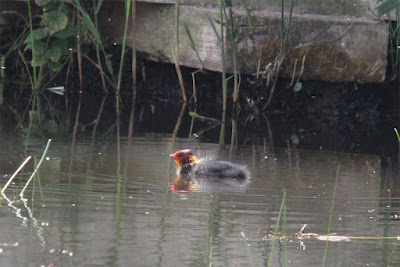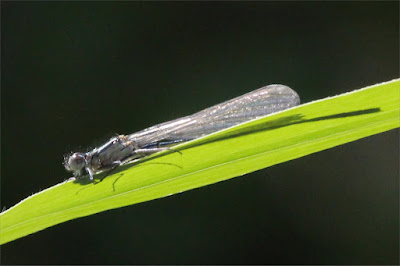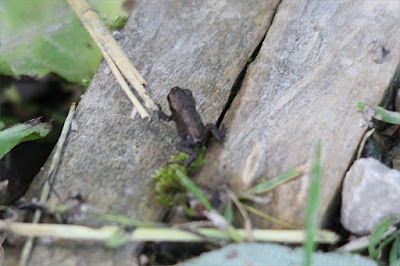 |
| Marsh tit |
I thought it more than high time I had a visit to Leighton Moss and, for once, the trains behaved impeccably in both directions. It had started to rain when I arrived at Silverdale Station and seeing as I haven't yet replaced my flat cap I bought a cheap baseball cap in the RSPB shop to stop the raindrops tapping on my bald spot. Almost at once the clouds parted and it was a bright, sunny day thereafter.
There was a small, and very well-behaved, school party in the Hideout so I didn't get my eye in on the bird feeders. It hardly needed doing anyway as most of the birds on the pathways seem to have emerged from post-breeding moult and skulk.
The black-headed gulls dominated the pool at Lilian's Hide. A few were sitting on nests, there were no full-sized juveniles about. There were also a few loafing mallards and gadwalls and a couple of tufties and about forty coots. A couple of marsh harriers — a male and a female — drifted over the reeds and a few swifts wafted around on high.
I walked down through the reedbeds to the Tim Jackson Hide, accompanied by the songs of wrens, blackcaps, chiffchaffs and sedge warblers. Along the way a marsh tit broke off from demolishing a piece of moss on a tree trunk to come and see if I had any bird seed (I hadn't, and was made to feel very guilty about it).
Crossing over the little bridge over the main drain I managed to see a water rail swimming across the ditch before it disappeared into the reeds. I hear water rails all over the place and every so often catch tantalising glimpses of them, Leighton Moss is the only place I get to get a good look at them on a regular basis. I hadn't gone far when I heard the first reed warbler of the day and a pair of emperor dragonflies powered by, my first of the year and their identities confirmed by my bumping into a couple of common hawkers which looked positively dainty in comparison.
 |
| Spot the red deer hind (Her ears are just right of centre) |
The view from Tim Jackson Hide was fairly quiet with a few gadwall and mallards taking it easy and a pair of coots with a very young family. A red deer hind sat in the tall grass not fifty yards away, all but invisible save for the twitching of her ears. The main action was with the dragonflies: common blue damselflies zipped around the tops of the grasses while broad-bodied chasers chased each other around the pools.
 |
| Baby coot |
I wandered round to the Griesdale Hide with more reed warblers and some reed buntings singing in the background. I could hear the tapping pennies calls of bearded tits not far into the reeds and had just found where at least one of them was calling from when a hobby shot past at head height and over towards the hide. Everything went quiet after that. I saw the hobby again about five minutes later as it rose on the thermals and went soaring high over in the direction of the causeway. A willow warbler by the hide was still making a point of staying low in the bushes when I got there.
 |
| A pair of great black-backs and their youngster are occupying the osprey platform |
I didn't stop long in the Griesdale Hide, it seemed a shame to intrude on so many very loud conversations. I stayed long enough to see that the greater black-backs that have commandeered the osprey platform have a youngster, that the greylags didn't seem to, and that the mute swans had a couple of cygnets. A chap with more camouflage gear than the Eighth Army barged in amidst great fanfare and regaled the assembled with loud tales of his recent birdwatching successes. I made a discreet exit. Outside another pair of harriers were floating over the reeds and a buzzard was soaring high overhead.
 |
| I'm baffled by this small damselfly |
I was congratulating myself on my being able to identify all the damsels and dragons flying about the reedbeds when I spotted an oddity amongst the blue-tailed damsels flitting about a stream. It was slightly smaller and looked even more fragile and I haven't been able to make the identification at all. I does one good to be reminded not to get too cocky once in a while.
The common toadlets scrabbling across the path were a bit easier to identify.
 |
| Toadlet |
Walking back I bumped into my second mixed tit flock of the Autumn as it bumped into a family of blackcaps fossicking about in the hawthorns. For a good five minutes there was a confusion of blue tits, long-tailed tits, marsh tits, great tits and juvenile blackcaps and each time I thought one group or another had moved on some or all came back for another go. Once they'd finally gone I had to wait a minute or so for a sunbathing blackbird to budge up a bit so I could get past.
 |
| Juvenile long-tailed tit |
 |
| Juvenile blackcap |
 |
| Blackbird |
I was ready for a cup of tea and while I was having it I noticed that the noisy parties were drifting over to the causeway so I decided to give it a miss. I only had ten minutes to wait for the train straight through to Manchester so I took that. I had an old man's explorer ticket and the afternoon was still young so I should have moved on to someplace else but I couldn't find any useful train connections and I really couldn't be bothered faffing round anywhere for the best part of an hour so I called it a day. I'd had a couple of hours' exercise and there'd been plenty to see, there was no point in being greedy.













































